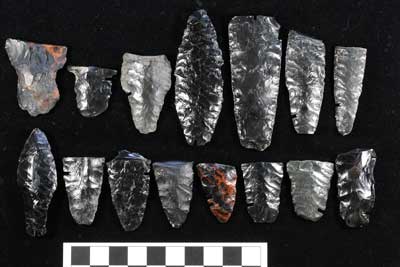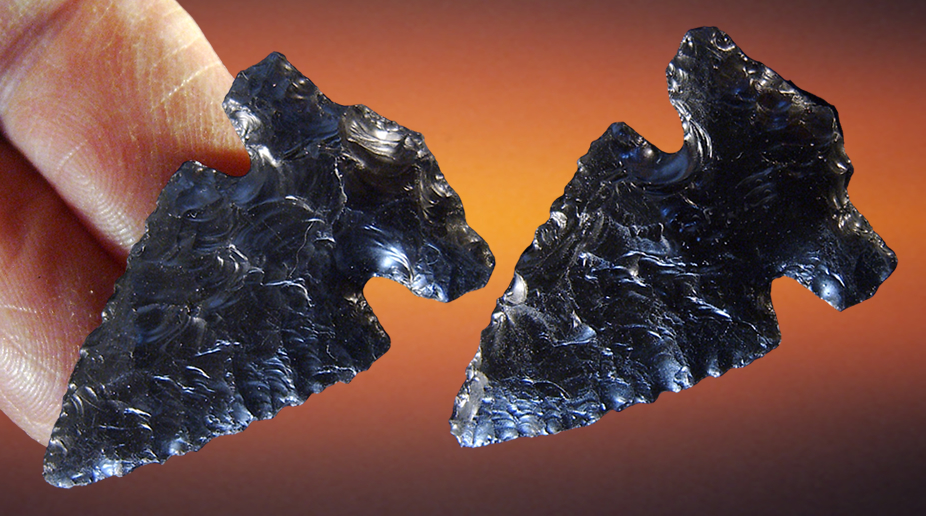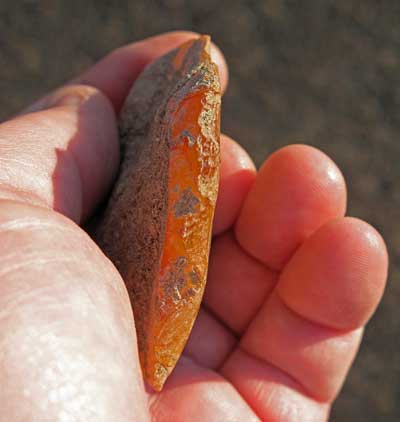It looks like you're using an Ad Blocker.
Please white-list or disable AboveTopSecret.com in your ad-blocking tool.
Thank you.
Some features of ATS will be disabled while you continue to use an ad-blocker.
22
share:
The orthodox view of how early humans settled the americas is slowly getting pushed back by new finds.
This newly post article sheds light on some of the earlier people in the western US.
The volcanic layer helps securely date this find.
This photo shows sometools found above the agate piece

Notice that these points are of the agate basin/sluiceway and related type points.
Their is an argument know that these points represent a culture separate from clovis or the western stemmed tradition,and that these people ultimately back migrated from south america.
Even though they have the good evidence they are still dancing aroung the bush with the find and not accepting their own dating, with this statement.
Exciting stuff
Stone Tool Unearthed in Oregon ‘Hints’ at Oldest Human Occupation in Western U.S.
This newly post article sheds light on some of the earlier people in the western US.
A colorful hand tool discovered in Oregon, and described as an “ancient Swiss army knife,” may be the oldest artifact yet found in western North America, archaeologists say.
The simple stone tool, hewn from a piece of bright orange agate, was unearthed near a shallow cave that has already turned up evidence of early human occupation — including stone points, tools, and charcoal-stained hearths — dating back as much as 12,000 years.
Rimrock Draw Oregon stone tool
This orange agate stone tool, found buried beneath a layer of 15,800-year-old volcanic ash, may be the oldest artifact yet found in western North America, archaeologists say.
"This orange agate stone tool, found buried beneath a layer of 15,800-year-old volcanic ash, may be the oldest artifact yet found in western North America, archaeologists say. (Photo courtesy University of Oregon Archaeological Field School)"
But this artifact was found even deeper in the region’s sandy clay, beneath a layer of volcanic ash that experts have found to be 15,800 years old.
If its age is confirmed, the tool would be nearly 3,000 years older than the widespread artifacts of the Clovis culture, once thought to be the continent’s earliest inhabitants.
The volcanic layer helps securely date this find.
“This is really exciting,” said Stephen Baker, spokesman for the Oregon office of the U.S. Bureau of Land Management, in an interview. “But of course there’s more research to do.”
The hand-sized tool was first unearthed in 2012 by the University of Oregon’s archaeology field school, at a site in south-central Oregon known as Rimrock Draw Rockshelter, on BLM land.
The fact that it was found beneath — and was therefore presumably older than — the layer of ancient ash was “fascinating” in itself, Baker said.
But last week, a chemical analysis of the artifact revealed that it also contained traces of proteins from bison, confirming that it had been used as a tool.
“Getting this bison residue further corroborated the idea that it was a tool, likely used for butchering,” Baker said.
Dr. Patrick O’Grady of the University of Oregon, who has been leading the excavations, said that the discovery came about after his field school uncovered debris from an ancient rockfall near the cave.
“Our excavation units had reached a jumbled layer of rockfall that appeared to be the result of a collapse of portions of the rockshelter face,” O’Grady said in an interview.
“We wanted to break that material up and clear a path so we could continue excavating to the bedrock underneath.”
"
Now sagebrush country, the terrain around Rimrock Draw Rockshelter was likely much wetter when the artifacts found there were originally used. (Courtesy University of Oregon Archaeological Field School)"
And beneath those, they hit a sudden, even layer of volcanic ash and rock, called tephra.
Experts from Washington State University analyzed the ash, and were able not only to radiocarbon date it to about 15,800 years ago, but were also able to isolate its source: Washington’s Mount St. Helen’s.
“We found the stone tool 20 centimeters under the Mount St. Helen’s tephra, in dense sandy clay sediment,” O’Grady said.
Baker, of the BLM, said researchers quickly identified the object as a tool.
“When they found it, they kind of joked that it was like an ancient swiss army knife,” he said.
“One edge, they believe, was used for scraping animal hide, and another side that’s been worn down over the years they believe was used for carving wood or bone. So, there are a couple of theories, but they think this is kind of a multi-purpose tool.”
The archaeologists were also struck by the tool’s unusual material, he added.
“It’s this bright orange agate,” Baker said. “In that area, there’s a lot of obsidian, but they’d never seen this material in that area before. So it really raises a lot of questions.
“They’re fascinated with, how did this tool get here? Where did it come from? What did they use it for?”
This photo shows sometools found above the agate piece

Notice that these points are of the agate basin/sluiceway and related type points.
Their is an argument know that these points represent a culture separate from clovis or the western stemmed tradition,and that these people ultimately back migrated from south america.
Even though they have the good evidence they are still dancing aroung the bush with the find and not accepting their own dating, with this statement.
“We all know the significance of the Paisley Caves site, with the exquisite fieldwork, sequence of radiocarbon dating, and well dated human fecal material that has firmly placed the site among very few in the Americas that are established as pre-Clovis occupations,” he said.
In an attempt to find a comparable body of evidence, he added, the coming field season at Rimrock Draw will be devoted largely to identifying the size of the 15,800-year-old layer of volcanic ash, and testing to see if more artifacts await beneath it.
“Rimrock has to produce strong dateable evidence through either cultural features or stratigraphic time markers to begin any conversation about its place in the realm on pre-Clovis sites,” O’Grady said.
“We have a hint of such a possibility through the association of the orange flake tool 20 centimeters under the Mount St. Helens tephra.
“But, it is only that — a hint — until we can show that the tephra is widely distributed across the site and that artifacts are found consistently underneath it.
“It is at that point that the work really begins,” he continued, “to verify the relationship in collaboration with other Paleoamerican researchers and conduct vast amounts of geological and archaeological analyses to firmly establish the relationship.
Exciting stuff
Stone Tool Unearthed in Oregon ‘Hints’ at Oldest Human Occupation in Western U.S.
Looks like they didn't quite finish the flaking on those heads. It's missing the place to hang it on the leather strap. He/she probably buried
them next to a marker in the cliff so they could be found and finished. Something might have happened to the person. Look at the weird design in the
rock cliff there, it would be a good place to bury something and find it later.
Well, these definitely do not show a person died or was buried there anyway otherwise they would have the strap hooks on them. I wonder if the indians always buried their dead braves with these things. The design and material they used could actually identify the tribe they belonged to.
Well, these definitely do not show a person died or was buried there anyway otherwise they would have the strap hooks on them. I wonder if the indians always buried their dead braves with these things. The design and material they used could actually identify the tribe they belonged to.
Is there a resource to display what we know about volcanism in the America's?
I an intrigued at the Mt St Helens eruption, and its timing.
I an intrigued at the Mt St Helens eruption, and its timing.
a reply to: punkinworks10
Nice one!
Oregon University Data
That link goes to the nice website recording the Archaeology in that site.
I used to own land in the general area and visited the abandoned houses of homesteaders from 1890s. They were not successful at farming in sage brush terrain they moved away...far away in fact.
Nice one!
Oregon University Data
That link goes to the nice website recording the Archaeology in that site.
I used to own land in the general area and visited the abandoned houses of homesteaders from 1890s. They were not successful at farming in sage brush terrain they moved away...far away in fact.
a reply to: bigfatfurrytexan
My link above and "to home" and searching may get an answer to your question.
My link above and "to home" and searching may get an answer to your question.
originally posted by: rickymouse
Looks like they didn't quite finish the flaking on those heads. It's missing the place to hang it on the leather strap. He/she probably buried them next to a marker in the cliff so they could be found and finished. Something might have happened to the person. Look at the weird design in the rock cliff there, it would be a good place to bury something and find it later.
Well, these definitely do not show a person died or was buried there anyway otherwise they would have the strap hooks on them. I wonder if the indians always buried their dead braves with these things. The design and material they used could actually identify the tribe they belonged to.
If you are refering to notches, such as these on this northern side notched point,

from idaho ca 4000BCE,(lithiccastinglab.com...)
they didnt come into use until much later, but in the western stemmed tradition, of which the the lower left and third from left on top row are good examples , the stem serves the the same hafting purpose.
The classic fluted and non fluted lanceolate points were hafted in a different manor, not using the familiar notches.
edit on 9-3-2015 by punkinworks10 because: (no reason given)
a reply to: Granite
right on,
Thanks for the link,
From a rough glance at the article, it appears as though several different groups of people inhabited the cave, i wonder if at the same time.
i had relatives that lived in the area when i was younger,
never found anything cool like that.
it would have been a hard place to homestead.
right on,
Thanks for the link,
From a rough glance at the article, it appears as though several different groups of people inhabited the cave, i wonder if at the same time.
i had relatives that lived in the area when i was younger,
never found anything cool like that.
it would have been a hard place to homestead.
edit on 9-3-2015 by punkinworks10 because: (no reason given)
During my undergrad days digging at Black Water Draw, NM; we always knew the date of Early Man in the Americas would eventually be pushed back to
25+K years ago. Dr. G. Agigino RIP, you were brilliant.
originally posted by: punkinworks10
originally posted by: rickymouse
Looks like they didn't quite finish the flaking on those heads. It's missing the place to hang it on the leather strap. He/she probably buried them next to a marker in the cliff so they could be found and finished. Something might have happened to the person. Look at the weird design in the rock cliff there, it would be a good place to bury something and find it later.
Well, these definitely do not show a person died or was buried there anyway otherwise they would have the strap hooks on them. I wonder if the indians always buried their dead braves with these things. The design and material they used could actually identify the tribe they belonged to.
If you are refering to notches, such as these on this northern side notched point,
from idaho ca 4000BCE,(lithiccastinglab.com...)
they didnt come into use until much later, but in the western stemmed tradition, of which the the lower left and third from left on top row are good examples , the stem serves the the same hafting purpose.
The classic fluted and non fluted lanceolate points were hafted in a different manor, not using the familiar notches.
Put some little clasps on those two points you showed and I bet I know half a dozen women who would buy them for earings. They would also make a good necklace.
Hanging it around your neck is a good way to carry a knife and also something to start a fire if you didn't have pockets.[
edit on 9-3-2015 by
rickymouse because: (no reason given)
a reply to: rickymouse
Err...I think those are two sides of the same point. Everything else you said still stands, though lol.
Err...I think those are two sides of the same point. Everything else you said still stands, though lol.
new topics
-
Thousands Of Young Ukrainian Men Trying To Flee The Country To Avoid Conscription And The War
Other Current Events: 1 hours ago -
12 jurors selected in Trump criminal trial
US Political Madness: 3 hours ago -
Iran launches Retalliation Strike 4.18.24
World War Three: 4 hours ago -
Israeli Missile Strikes in Iran, Explosions in Syria + Iraq
World War Three: 4 hours ago -
George Knapp AMA on DI
Area 51 and other Facilities: 10 hours ago -
Not Aliens but a Nazi Occult Inspired and then Science Rendered Design.
Aliens and UFOs: 10 hours ago
top topics
-
BREAKING: O’Keefe Media Uncovers who is really running the White House
US Political Madness: 17 hours ago, 25 flags -
George Knapp AMA on DI
Area 51 and other Facilities: 10 hours ago, 25 flags -
Israeli Missile Strikes in Iran, Explosions in Syria + Iraq
World War Three: 4 hours ago, 13 flags -
Louisiana Lawmakers Seek to Limit Public Access to Government Records
Political Issues: 12 hours ago, 7 flags -
So I saw about 30 UFOs in formation last night.
Aliens and UFOs: 15 hours ago, 6 flags -
Iran launches Retalliation Strike 4.18.24
World War Three: 4 hours ago, 5 flags -
Not Aliens but a Nazi Occult Inspired and then Science Rendered Design.
Aliens and UFOs: 10 hours ago, 5 flags -
Do we live in a simulation similar to The Matrix 1999?
ATS Skunk Works: 16 hours ago, 4 flags -
The Tories may be wiped out after the Election - Serves them Right
Regional Politics: 13 hours ago, 3 flags -
12 jurors selected in Trump criminal trial
US Political Madness: 3 hours ago, 2 flags
active topics
-
President BIDEN Warned IRAN Not to Attack ISRAEL - Iran Responded with a Military Attack on Israel.
World War Three • 43 • : WeMustCare -
Israeli Missile Strikes in Iran, Explosions in Syria + Iraq
World War Three • 52 • : WeMustCare -
Mandela Effect - It Happened to Me!
The Gray Area • 107 • : inflaymes69 -
Terrifying Encounters With The Black Eyed Kids
Paranormal Studies • 45 • : daskakik -
Not Aliens but a Nazi Occult Inspired and then Science Rendered Design.
Aliens and UFOs • 12 • : BeyondKnowledge3 -
Elites disapearing
Political Conspiracies • 31 • : Degradation33 -
MULTIPLE SKYMASTER MESSAGES GOING OUT
World War Three • 47 • : SchrodingersRat -
12 jurors selected in Trump criminal trial
US Political Madness • 21 • : VictorVonDoom -
British TV Presenter Refuses To Use Guest's Preferred Pronouns
Education and Media • 64 • : Degradation33 -
Iran launches Retalliation Strike 4.18.24
World War Three • 14 • : Cloudbuster1
22


